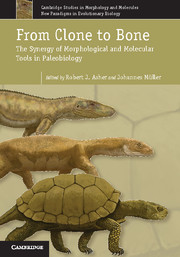Book contents
- Frontmatter
- Contents
- Contributors
- 1 Molecular tools in palaeobiology: divergence and mechanisms
- PART I Divergence
- 2 Genomics and the lost world: palaeontological insights into genome evolution
- 3 Rocking clocks and clocking rocks: a critical look at divergence time estimation in mammals
- 4 Morphological largess: can morphology offer more and be modelled as a stochastic evolutionary process?
- 5 Species selection in the molecular age
- PART II Mechanisms
- 6 Reconstructing the molecular underpinnings of morphological diversification: a case study of the Triassic fish Saurichthys
- 7 A molecular guide to regulation of morphological pattern in the vertebrate dentition and the evolution of dental development
- 8 Molecular biology of the mammalian dentary: insights into how complex skeletal elements can be shaped during development and evolution
- 9 Flexibility and constraint: patterning the axial skeleton in mammals
- 10 Molecular determinants of marsupial limb integration and constraint
- 11 A developmental basis for innovative evolution of the turtle shell
- 12 A molecular–morphological study of a peculiar limb morphology: the development and evolution of the mole's ‘thumb’
- 13 Manus horribilis: the chicken wing skeleton
- Index
- Plate-section
- References
3 - Rocking clocks and clocking rocks: a critical look at divergence time estimation in mammals
Published online by Cambridge University Press: 05 November 2012
- Frontmatter
- Contents
- Contributors
- 1 Molecular tools in palaeobiology: divergence and mechanisms
- PART I Divergence
- 2 Genomics and the lost world: palaeontological insights into genome evolution
- 3 Rocking clocks and clocking rocks: a critical look at divergence time estimation in mammals
- 4 Morphological largess: can morphology offer more and be modelled as a stochastic evolutionary process?
- 5 Species selection in the molecular age
- PART II Mechanisms
- 6 Reconstructing the molecular underpinnings of morphological diversification: a case study of the Triassic fish Saurichthys
- 7 A molecular guide to regulation of morphological pattern in the vertebrate dentition and the evolution of dental development
- 8 Molecular biology of the mammalian dentary: insights into how complex skeletal elements can be shaped during development and evolution
- 9 Flexibility and constraint: patterning the axial skeleton in mammals
- 10 Molecular determinants of marsupial limb integration and constraint
- 11 A developmental basis for innovative evolution of the turtle shell
- 12 A molecular–morphological study of a peculiar limb morphology: the development and evolution of the mole's ‘thumb’
- 13 Manus horribilis: the chicken wing skeleton
- Index
- Plate-section
- References
Summary
Introduction
Much has been written about the molecular revolution in phylogenetics and the ongoing conflict between molecules and morphology (Hillis 1987; Patterson 1987; Springer et al. 2004). With reference to therian mammals at least, the supposed conflict has been largely overblown: there is in fact general agreement between the two data sources, something unfortunately overshadowed by a handful of persistent ‘problem children’. The taxonomic content of most mammalian orders and other traditional higher-level taxa originally proposed purely on the basis of morphology has remained unscathed by the application of molecular sequence analysis. Even within these taxa, conflicts between molecular and morphological hypotheses of relationships are comparatively rare and usually relatively minor. For instance, a comparative study within Carnivora (Bininda-Emonds, 2000) revealed that most data sources and methods of analysis pointed at the same general solution, a few admittedly problematic taxa (e.g. Felidae) notwithstanding. In the end, the frequency and nature of disagreements over tree topology is arguably of the same order of magnitude within the separate spheres of molecular and morphological systematics as it is between them (Patterson et al. 1993). In many ways, the situation in mammals parallels that in vertebrates, where a fairly robust tree including gnathostomes, actinopterygians, sarcopterygians, tetrapods, amniotes and diapsids (among many other groups) has been supported by comparative anatomy since the 1800s (Asher and Müller, this volume).
Instead, many of the more celebrated conflicts in mammals tend to represent a lack of information, especially on the morphological side. The evolutionary tree of eutherian mammals presented by Novacek (1992), which exemplified the state-of-the-art morphological opinion at the time, is conspicuous today not for being very wrong (although some clades within it have been overturned by molecular information), but for its lack of resolution. Insectivora was long recognized to be a taxonomic wastebasket for any small brown mammal with sharp teeth that wasn't a rodent and couldn't fly.
- Type
- Chapter
- Information
- From Clone to BoneThe Synergy of Morphological and Molecular Tools in Palaeobiology, pp. 38 - 82Publisher: Cambridge University PressPrint publication year: 2012
References
- 4
- Cited by



